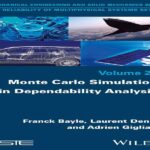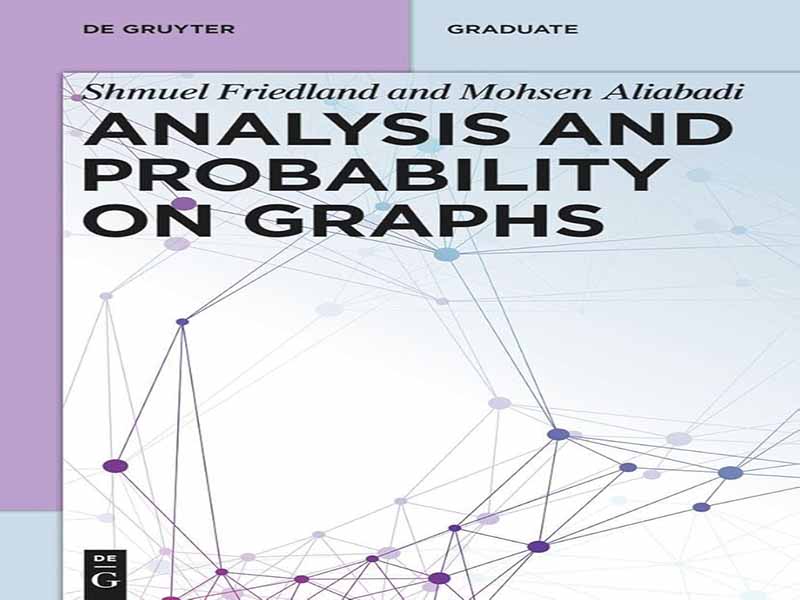- عنوان کتاب: Analysis and Probability on Graphs
- نویسنده: Shmuel Friedland and Mohsen Aliabadi
- حوزه: تحلیل گراف
- سال انتشار: 2025
- تعداد صفحه: 222
- زبان اصلی: انگلیسی
- نوع فایل: pdf
- حجم فایل: 5.84 مگابایت
تجزیه و تحلیل و احتمال روی نمودارها، که به اختصار APG نامیده می شود، یک چارچوب اساسی را در موضوعات مختلف ریاضی پیشرفته تشکیل می دهد. این به عنوان یک ابزار مهم در رشته هایی مانند علوم کامپیوتر، فیزیک، مهندسی، بیوانفورماتیک، اقتصاد و علوم اجتماعی، به ویژه در تجزیه و تحلیل پویایی رویدادهای در مقیاس بزرگ بر روی نمودارها عمل می کند. بسیاری از این پدیدههای پویا را میتوان از طریق فرآیندهای احتمالی مناسب که در نمودارهای بزرگ اعمال میشود، مدلسازی کرد. یکی از کاربردهای دنیای واقعی ترکیب نظریه گراف با تجزیه و تحلیل و احتمال، سناریوی شبکه اجتماعی است: شبکه اجتماعی را در نظر بگیرید که در آن کاربران بر اساس تعاملات یا علایق مشترکشان به هم متصل هستند. تجزیه و تحلیل این ارتباطات از طریق تئوری گراف، همراه با احتمال، می تواند توصیه های شخصی ایجاد کند. از دیدگاه تئوری گراف، کاربران را به عنوان گرهها در یک نمودار نشان دهید و در صورتی که کاربران با یکدیگر تعامل داشته باشند یا علائق مشترکی داشته باشند، آنها را با یالها وصل کنید. از دیدگاه احتمال، بر اساس قدرت یا فرکانس تعاملات بین کاربران متصل، احتمالات را به لبه ها اختصاص دهید. نمودار را برای شناسایی جوامع یا گروههایی از کاربرانی که رفتار یا ترجیحات مشابهی از خود نشان میدهند، تجزیه و تحلیل کنید. هنگامی که کاربر به یک مورد خاص (مانند یک فیلم، کتاب یا محصول) ابراز علاقه می کند، سیستم ممکن است احتمال علاقه را از طرف همتایان متصل خود پیش بینی کند. بر اساس ترجیحات همسایگان متصل خود در نمودار، احتمال اینکه کاربر مورد را دوست داشته باشد، محاسبه کنید. با توجه به ترجیحات اتصالات شبکه، مواردی را با بیشترین احتمال پسند شدن توسط کاربر توصیه کنید. با تکامل تعاملات کاربر و نمودار، توصیه ها را به صورت پویا تنظیم کنید. اهداف ما در بحثهایمان، درک انگیزه هر عبارت را بر غوطهور شدن در جزئیات اولویت میدهیم. رویکرد ما این است که در صورت امکان دقت را هدف قرار دهیم، اما در موارد دیگر، ما بر انتقال مفهوم هر عبارت تمرکز می کنیم. هدف اصلی کاوش و تبیین موضوعات مختلف در این راستا و ایجاد زمینه ای برای دانشجویان پیشرفته در مقاطع کارشناسی و کارشناسی ارشد در رشته های ریاضی، فیزیک و علوم کامپیوتر است. این کتاب به گونهای طراحی شده است که برای افرادی با درک پایهای از نظریه گراف و نظریه احتمال قابل دسترسی باشد و آن را برای دانشآموختگان سطح بالا و کسانی که درگیر مطالعه مستقل هستند، استفاده از آن به عنوان مرجع یا کاوش در تحقیقات با پیشزمینه اساسی در احتمالات و نظریه گراف مناسب است. از این کتاب می توان به عنوان کتاب درسی نیز استفاده کرد. پوشش همه این موضوعات در یک دوره تحصیلات تکمیلی یک ترم می تواند چالش برانگیز باشد. با این وجود، از آنجایی که بسیاری از بخشهای کتاب مستقل هستند، مربیان انعطافپذیری دارند تا بخشهای مربوطه را بر اساس نیازهای خاص خود انتخاب و ترکیب کنند. سازمان. از منظر تاریخی، این کتاب درسی از سالها تدریس دروس تئوری احتمال، نظریه گراف، ترکیبیات و نظریه ماتریس توسط اولین نویسنده در دانشگاه ایلینوی، شیکاگو نشات گرفته است. کتاب دارای هفت فصل است. چهار فصل اول ممکن است به عنوان یک کتاب درسی برای دوره های کارشناسی ارشد مرتبط با نظریه احتمال، پیاده روی تصادفی، و احتمال بر روی نمودارها در گروه های ریاضیات و علوم کامپیوتر ریاضی استفاده شود. مطالب تحت پوشش این فصل ها ممکن است برای بررسی مشکلات دنیای واقعی استفاده شود. سه فصل آخر برای دانشجویان تحصیلات تکمیلی به عنوان کتاب مرجع یا برای مطالعه یا تحقیق فردی در نظر گرفته شده است. مروری مختصر از محتویات آن ارائه می کنیم. فصل 1 بر مفاهیم اساسی در نظریه احتمال تمرکز دارد و جنبه هایی مانند فضای احتمال، متغیرهای تصادفی، مقادیر مورد انتظار و لحظه ها را پوشش می دهد. قضایای مربوط به ارزیابی احتمال یک متغیر تصادفی از جمله نابرابری مارکوف و نابرابری چبیشف ارائه شده است. برخی از متغیرهای تصادفی مهم مانند متغیرهای تصادفی برنولی، دوجمله ای و پواسون و خواص آنها مورد بحث قرار می گیرند. فصل 2 به نمودارهای بدون جهت و جهت دار اختصاص دارد. ابتدا مفاهیم اساسی نمودارهای بدون جهت را بررسی می کنیم. ما پیادهرویها، مسیرها و مسیرها را در نمودارهای بدون جهت بررسی میکنیم، همچنین این مفاهیم را در درختها و نمودارهای دوبخشی به همراه نتایج مرتبط بررسی میکنیم. پس از آن، مدارهای اویلری را طبقه بندی می کنیم. ما مفاهیم اساسی نمودارها (نمودارهای جهت دار) را معرفی می کنیم و تمرکز خود را به ارتباط در نمودارها تغییر می دهیم. در نهایت، ما با استفاده از ابزارهای تئوری اعداد، مانند نتایج مربوط به اعداد فروبنیوس، نمودارهای بهشدت مرتبط را طبقهبندی میکنیم. در فصل 3، دو مدل نمودار تصادفی متداول مورد استفاده، مدلهای گیلبرت و اردو-رنی را مورد بحث قرار میدهیم. ما مفاهیم این دو مدل را برای تجزیه و تحلیل اتصال گراف بررسی می کنیم. ما به ویژگی k-clique گراف ها می پردازیم، ابزاری برای شناسایی زیرگراف های “چگال” در یک گراف معین. ما همچنین رئوس و اتصالات جدا شده را مطالعه می کنیم و توابع آستانه را از طریق توزیع پواسون بررسی می کنیم. در فصل 4، ماتریس های مجاورتی را برای گراف های بدون جهت و جهت دار معرفی می کنیم که بررسی انواع مختلف را تسهیل می کند.
Analysis and Probability on Graphs, abbreviated as APG, forms a foundational framework across various advanced mathematical topics. It serves as a critical tool in disciplines such as computer science, physics, engineering, bioinformatics, economics, and social sciences, particularly in analyzing the dynamics of large-scale events on graphs. Many of these dynamic phenomena can be modeled through appropriate probabilistic processes applied to large graphs. One real-world application of combining graph theory with analysis and probability is the social network scenario: Consider a social network where users are connected based on their interactions or shared interests. The analysis of these connections through graph theory, combined with probability, can produce personalized recommendations. From graph theory perspective, represent users as nodes in a graph and connect users with edges if they have interacted or shared common interests. From probability perspective, assign probabilities to edges based on the strength or frequency of interactions between connected users. Analyze the graph to identify communities or groups of users who exhibit similar behavior or preferences. When a user expresses interest in a particular item (such as a movie, book, or product), the system may predict the likelihood of interest from their connected peers. Calculate the probability that the user will like the item based on the preferences of their connected neighbors in the graph. Recommend items with the highest probability of being liked by the user, considering the preferences of their network connections. Adjust recommendations dynamically as the user’s interactions and the graph evolve. Our goals. In our discussions, we prioritize understanding the motivation of each statement over getting immersed in details. Our approach is to aim for rigor where possible, but in other cases, we focus on conveying the concept of each statement. The main goal is to explore and explain various topics in this direction and provide a background for advanced undergraduate and graduate students in mathematics, physics, and computer science. The book is designed to be accessible to individuals with a basic understanding of graph theory and probability theory, making it suitable for upper-level undergraduates and those involved in independent study, using it as a reference, or exploring research with a basic background in probability and graph theory. The book may also be used as a textbook. Covering all these topics in a one-semester graduate course could be challenging. Nevertheless, since many sections of the book are independent, instructors have the flexibility to select and incorporate relevant sections based on their specific needs. Organization. From historical perspective, this textbook originates from years of teaching courses in probability theory, graph theory, combinatorics, and matrix theory by the first author at the University of Illinois, Chicago. The book has seven chapters. The first four chapters may be used as a textbook for advanced undergraduate courses related to probability theory, random walks, and probability on graphs in mathematics and mathematical computer science departments. The materials covered in these chapters may be used to investigate real-world problems. The last three chapters are intended for graduate students as a reference book or for individual study or research. We provide a brief overview of its contents. Chapter 1 focuses on fundamental concepts in probability theory, covering aspects such as probability space, random variables, expected values, and moments. Theorems related to assessing the probability of a random variable, including Markov’s inequality and Chebyshev’s inequality, are presented. Certain important random variables such as Bernoulli, binomial, and Poisson random variables and their properties are discussed. Chapter 2 is devoted to undirected and directed graphs. We first review the basic notions of undirected graphs. We explore walks, trails, and paths in undirected graphs, as well as examine these concepts in trees and bipartite graphs, along with associated results. Subsequently, we classify Eulerian circuits. We introduce the basic notions of digraphs (directed graphs) and shift our focus to connectedness in digraphs. Finally, we classify strongly connected digraphs by leveraging tools from number theory, such as results concerning Frobenius numbers. In Chapter 3, we discuss two commonly used random graph models, Gilbert’s and Erdös– Rényi’s models. We scrutinize the implications of these two models for graph connectivity analysis. We address the k-clique property of graphs, a tool for identifying the “dense” subgraphs within a given graph. We also study isolated vertices and connectivity, investigating threshold functions through the Poisson distribution. In Chapter 4, we introduce adjacency matrices for both undirected and directed graphs, facilitating the examination of various graph properties such as vertex degrees, walk enumeration, identification of odd cycles, and connectivity analysis. We also cover block matrices in the context of strong connectivity in directed graphs, alongside discussions on reduced graphs and reducible matrices. In Chapter 5, we explore Markov chains: what they are, how to simulate them, and how they behave on graphs. We analyze stationary distributions and their properties, along with spectral properties of matrices related to Markov chains. We cover reversible Markov chains and then move on to a short discussion of the Perron–Frobenius theorem. We conclude the chapter with a discussion of the mean first passage time, mean recurrence time, and the Kemeny constant of a Markov chain. Chapter 6 links symbolic dynamics with graph theory by interpreting sequences as graph walks, exemplified by a Fibonacci sequence. It covers hard-core configurations, their recurrence relations, and the MCMC algorithm. The Shannon capacity for a digraph G with cycles is introduced, related to the spectral radius of its adjacency matrix. The chapter also defines entropy H(μ) for a distribution μ, explores the pressure function and its properties, and a pressure gradient simulation. In Chapter 7, on a subshift of finite type, we introduce a pseudo-metric defined by a nonnegative matrix that satisfies the cycle condition. We determine the exact value of the Hausdorff dimension for a G∞, induced by a digraph G, with respect to this specific pseudo-metric. We also evaluate the Hausdorff dimension of the limit set of a finitely generated free group of isometries acting on a locally finite tree.
این کتاب را میتوانید از لینک زیر بصورت رایگان دانلود کنید:
Download: Analysis and Probability on Graphs




































نظرات کاربران